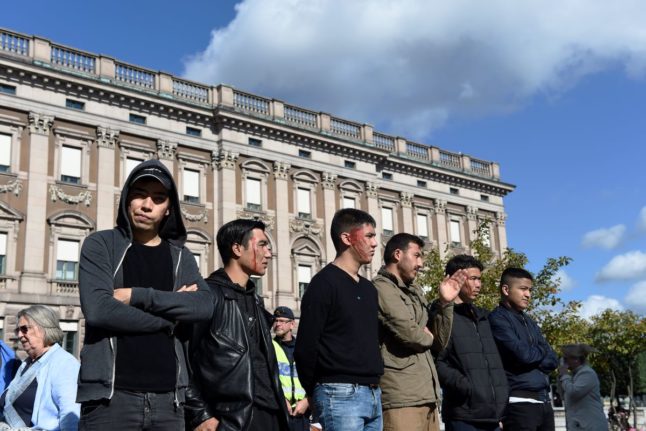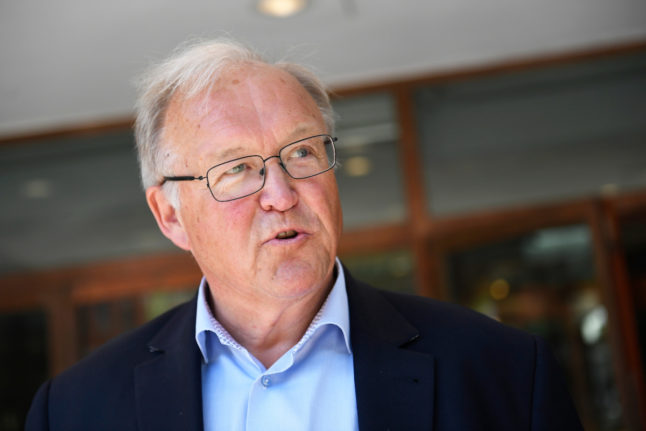Some 35,000 unaccompanied child refugees came to Sweden during the refugee crisis of 2015, the overwhelming majority of whom were teenage boys from Afghanistan’s oppressed Hazara minority. Only 2,847 were girls, and 22,806 of the 32,522 boys were from Afghanistan.
According to the Statistics Sweden report, around 13,000 of them were then given residency as unaccompanied child refugees, with a further 7,000 given residency under the so-called “Gymnasium Law” or gymnasielagen.
This was an amnesty law which gave those whose asylum claims were rejected temporary residency in Sweden to complete their studies at upper secondary school, after which they had six months to get a job.
A poor welcome
On arrival in Sweden, the group were often dismissed as skäggbarn, or “bearded children”, with claims that many had lied about their age to take advantage of more lenient asylum rules. The Swedish National Board of Forensic Medicine was tasked with carrying out controversial examinations to check their ages.
The group were blamed for harassing girls at music festivals, and there were also reports of their being drawn into heroin use and crime.
Most have jobs
Six years on, though, the statistics show a more positive picture.
Of those born in 1999, the most common age for the group, 82 percent of the young men were described as sysselsatta or “employed” in November 2022, when the snapshot was taken, a number that rises to 85 percent for men who received residency under the Gymnasium Law.
This compares to about 66 percent for young men born in Sweden in 1999, and about 74 percent for young refugees who came to Sweden with their parents in 2015.
According to the study, 71 percent of those with residency under the Gymnasium Law and 67 percent of those with residency as unaccompanied child refugees have an income of at least 222,900 kronor year, or about 18,575 kronor a month, which was more than both young men born in Sweden (48 percent) and refugees who came with their parents (46 percent).
In a sense, the high employment rate among those who gained residency under the Gymnasium Law is not surprising, given that they were given six months to get a job or risk being deported.
“The explanation is usually that they are dependent on themselves for support, so they more or less have to get a job to be able to take care of themselves,” Karin Lundström, the demographer at Statistics Sweden who led work on the report, told The Local.
Muhammed Ali, Chair of Sweden’s Association of Unaccompanied Child Refugees, told the broadcaster TV4 that the findings were expected.
“This report is nothing that surprises us, because both we ourselves and those who support us know how well it’s going for us,” he said.
But he said that the group’s success had come despite the often harsh treatment they have received in Sweden.
“We’ve been struggling over these years. We’ve been treated extremely badly and brutally. We have never been a priority for the authorities, but we have also managed to create a network,” he said.
Most work in elderly and healthcare
The study found that the most common job for the group was health and elderly care or social care, with 38 percent of men who got residency as child refugees employed in these roles and 34 percent who got residency under the Gymnasium Law. This compares to just five percent of men born in Sweden.
“We can see that a larger share of those with [residency under] the Gymnasium Law are working in healthcare, which is a profession where there’s a lot of need for for people,” Lundström explained. “So we can see that they have chosen a profession and education which matches the jobs in demand.
The next biggest roles were “business services” or företagstjänster, a broad term which can cover everything from high-level IT services to janitorial work, which employed 14 percent of those those given residency as unaccompanied child refugees and 12 percent of those who got residency under the Gymnasium Law, manufacturing and recycling, retail, hotel and restaurant, and the building industry – which all employed around 10 percent.
Very few are studying, and many didn’t graduate from upper secondary
The downside of the Gymnasium Law was that it forced those given residency under it to go directly into the workforce after completing upper secondary education, as going into higher education did not count as grounds for extended residency.
Only 3 percent of men who got residency as unaccompanied child refugees were studying in November 2022, compared to 17 percent of those born in Sweden and nearly 11 percent of those who came with their parents.
For women born in 1999 who came as child refugees, it was 7 percent, while for those born in Sweden or who arrived as refugees with their parents, the share studying was 20 percent.
Some 55 percent of men who got residency as child refugees have studied to gymnasium level, and fully 75 percent of those who got residency under the Gymnasium Law, but only about 4 percent of male child refugees have studied to a higher level, and only 2 percent of men who received residency under the Gymnasium Law.
Almost all of those who studied chose a vocational line: 80 percent of child refugees, and fully 94 percent of men who got residency under the Gymnasium Law.
Only 6 percent of those who got residency under the Gymnasium Law studied a programme at upper secondary school which counts as preparation for further education.
For men who got residency as child refugees, only 15 percent studied a programme expected to lead to further education, while for women the share was 18 percent.
Of those born in Sweden, fully 44 percent studied courses leading to further education, and for those who came with their parents, 40 percent did.
Lundström said she expected that this might change in future as more decided to improve their skills through study.
“It’s not been that long since they finished upper secondary school and got their first jobs, so maybe if we were to look at this group in another five or 10 years, it would be a little bit different and a higher share of them would have started and finished higher studies.”
Many have very low salaries
According to the report, more than 70 percent of men who gained residency under the Gymnasium Law have an income of at least three “income base payments” or inkomstbasbelopp.
As an income base payment was set at 71,000 kronor in 2022, this constitutes an income of 213,000 kronor, or 17,750 kronor a month.
Around 30 percent of those with residency under the Gymnasium Law earned even less than this, and with those with residency as child refugees the number is more like 35 percent.
There is no information in the study on how many of those earning “at least 17,750 a month” earned 26 700 kronor, which was the average salary for a care home assistant in 2022.
Lundström warned that the figures could be misleading here as many of those in the study would not have worked a full year by November 2022.
Even in November 2022, she said, about 50 percent of those studied had an annual income corresponding to about 25,000 kronor per month.



 Please whitelist us to continue reading.
Please whitelist us to continue reading.
Member comments